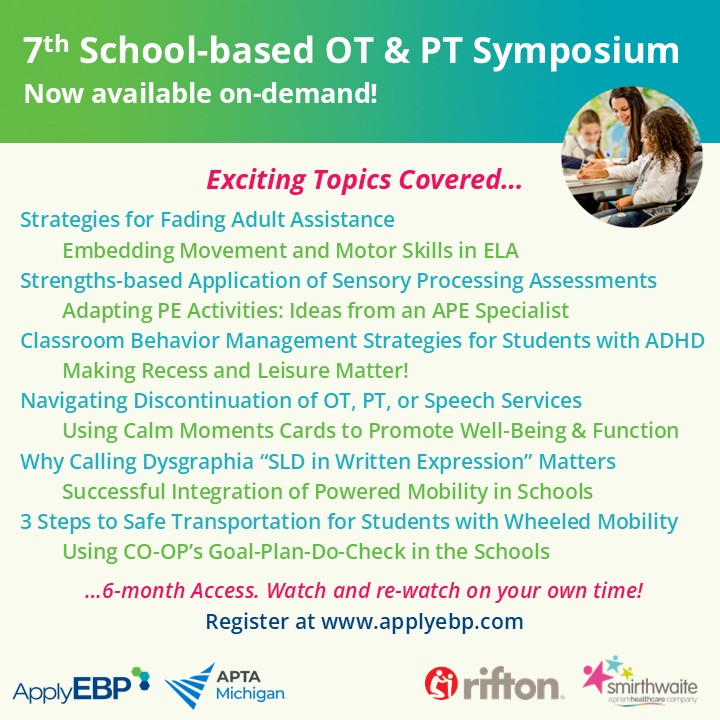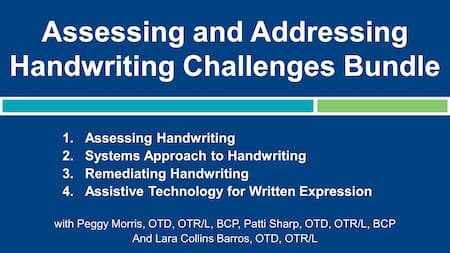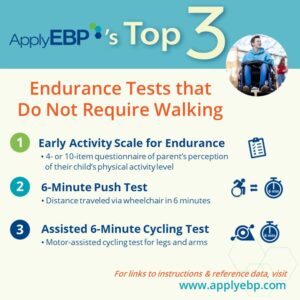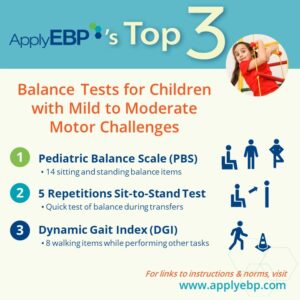Ask Apply EBP
Research Roundup: Pencil Grasp and Legibility
Apply EBP’s “Research Roundup” is a blog post series that serves as your go-to resource for peer-reviewed studies focusing on commonly-discussed topics relevant to OT, PT, and SLP practice. Each installment provides you a compilation of published research to inform your decision-making and to share with your team.
Q: Does pencil grasp impact legibility? Should I work on changing grasps?
In this edition of Ask Apply EBP, we present an array of research studies on the impact of different pencil grasp patterns on handwriting legibility published since 2001. While we provide a concise summary of the overall findings in our Big Picture Summary, we encourage you to delve into the individual articles that pique your interest for a deeper understanding.
We provide key excerpts or insights from each study. All the studies we reference are sourced from peer-reviewed journals and are arranged from the most recent to the oldest.
Further highlighting our suggestion to read the full articles before applying the lessons into your own practice, scroll down to the end of the list. You will find our findings when we dug deeper into a scoping review from 2023. We read it, plus the articles they referenced to support their conclusions. If we skipped the additional reading and relied solely on the article’s conclusion, our understanding would have been limited and flawed.
Want a PDF Document version of this list that you can easily share with your team via print or email? Join Apply EBP’s Facebook Discussion Group by clicking here to download one.
We are committed to maintaining the relevance of this resource. If you have additional peer-reviewed research to contribute, please email it to applyebp@gmail.com with the subject “For Research Roundup” and the topic (e.g., For Research Roundup: Weighted Vests).
Thank you for your participation!
The Big Picture
-
-
- There are numerous studies across age groups, from 1st- to 4th- grade, and college students comparing “mature” and “immature” grasps. While some studies include children with health conditions, most include only students with “typical development”.
- Outcomes measured: mostly legibility, but some also measured speed
- Results: In general, studies showed no significant difference in legibility among different grasp patterns. In general, legibility decreased after 10 minutes of activity, irrespective of grasps.
- Our take: Focus on strategies that have been shown to improve legibility, and less on splinter skills like pencil grasp or sensorimotor interventions. Read Apply EBP’s article: “Top 3 Effective Handwriting Interventions”. If you are considering working on changing grasp, ask: Is the current grasp functional? What is the student’s potential and motivation for changing grasps? Is Assistive Technology more appropriate for improving productivity?
-
Studies from Peer-Reviewed Journals
Aktaş, N. (2023). Does Primary Students’ Writing Ergonomics Affect Their Handwriting Legibility?. Language Teaching and Educational Research, 6(1), 24-38.
-
-
- 450 primary school students studying in the 1st, 2nd, 3rd and 4th grades
- “right handed students were found to write more legibly than the left-handed ones. However, the writing ergonomics of the students (i.e., notebook/paper positions, pencil gripping styles and pencil gripping point) seemed to have no significant impact on the legibility of the writing.”
-
Donica, D. K., Massengill, M., & Gooden, M. J. (2018). A quantitative study on the relationship between grasp and handwriting legibility: does grasp really matter?. Journal of Occupational Therapy, Schools, & Early Intervention, 11(4), 411-425.
-
-
- 46 first- and second-grade students
- “there were no statistically significant differences between legibility scores on these two assessments for first- and second-grade students when grouped by pencil grasp.”
-
Shah, L. J., & Gladson, B. L. (2015). The relationship of pencil grasp on college students’ handwriting speed and legibility. Journal of Occupational Therapy, Schools, & Early Intervention, 8(2), 180-191.
-
-
- “pencil grasp had no effect on handwriting speed and legibility in college students.”
-
Schwellnus, H., Carnahan, H., Kushki, A., Polatajko, H., Missiuna, C., & Chau, T. (2013). Writing forces associated with four pencil grasp patterns in grade 4 children. The American Journal of Occupational Therapy, 67(2), 218-227.
-
-
- 74 Grade 4 students
- “Grip forces were generally similar across the different grasps. Kinetic differences resulting from thumb position seemed to have no bearing on speed and legibility. Interventions for handwriting difficulties should focus more on speed and letter formation than on grasp pattern.”
-
Schwellnus, H., Carnahan, H., Kushki, A., Polatajko, H., Missiuna, C., & Chau, T. (2012). Effect of pencil grasp on the speed and legibility of handwriting after a 10‐minute copy task in Grade 4 children. Australian Occupational Therapy Journal, 59(3), 180-187.
-
-
- 120 Grade 4 students
- “For both typically developing children and those with handwriting issues, the legibility of the writing samples decreased after the 10-minute copy task but the speed of writing increased…The dynamic tripod pencil grasp did not offer any advantage over the lateral tripod or the dynamic or lateral quadrupod pencil grasps in terms of quality of handwriting after a 10-minute copy task.”
-
Schwellnus, H., Carnahan, H., Kushki, A., Polatajko, H., Missiuna, C., & Chau, T. (2012). Effect of pencil grasp on the speed and legibility of handwriting in children. The American Journal of Occupational Therapy, 66(6), 718-726.
-
-
- 120 fourth-grade students who were typically developing
- “Pencil grasp patterns did not influence handwriting speed or legibility in this sample of typically developing children. This finding adds to the mounting body of evidence that alternative grasps may be acceptable for fast and legible handwriting.”
-
Falk, T. H., Tam, C., Schwellnus, H., & Chau, T. (2010). Grip force variability and its effects on children’s handwriting legibility, form, and strokes.
-
-
- 35 students (19 males), 16 in first grade and 19 in second grade
- “students with writing difficulties exhibited more static grip force patterns, lower legibility and form scores, as well as increased variation in stroke durations.”
-
Kavak, S. T., & Bumin, G. (2009). The effects of pencil grip posture and different desk designs on handwriting performance in children with hemiplegic cerebral palsy. Jornal de pediatria, 85, 346-352.
-
-
- 26 children with left hemiplegic cerebral palsy and 32 children with typical development
- “The results of our study demonstrated that the pencil grip patterns have no effect on the handwriting parameters in both children with cerebral palsy and healthy children. It is recommended that a cutout table be used to provide more upper extremity support in handwriting activities for students with cerebral palsy.”
-
Koziatek, S. M., & Powell, N. J. (2003). Pencil grips, legibility, and speed of fourth-graders’ writing in cursive. The American journal of occupational therapy, 57(3), 284-288.
-
-
- 4th Grade: 95 students with typical development and 6 students receiving special education services
- “This study found the lateral quadrupod and four-finger pencil grips to be as functional as the dynamic tripod, lateral tripod, and dynamic quadrupod pencil grips.” “Mean cursive writing speeds were similar for all pencil grips except for the interdigital grasp.”
-
Dennis, J. L., & Swinth, Y. (2001). Pencil grasp and children’s handwriting legibility during different-length writing tasks. The American Journal of Occupational Therapy, 55(2), 175-183.
-
-
- 46 fourth-grade students who were typically developing
- “Students’ legibility was greater on the short task than on the long task across both grasp conditions. No significant difference was found in scores between students who used dynamic tripod grasps and those who used atypical grasps, nor was there a significant interaction between grasp and task length.”
-
A Scoping Review that Needs to Be Read with Caution
Schneider, M. K., Myers, C. T., Morgan-Daniel, J., & Shechtman, O. (2023). A Scoping Review of Grasp and Handwriting Performance in School-Age Children. Physical & Occupational Therapy In Pediatrics, 43(4), 430-445.
-
-
- Their abstract states: “Findings suggest an inefficient grasp can lead to decreased handwriting legibility and fatigue.”
- In the “Application” section of the study, they reported “inconsistencies” in findings among different studies, citing 9 studies:
- 4 studies did not find a relationship between grasp and handwriting (Burton & Dancisak, 2000; Dennis & Swinth, 2001; Donica et al., 2018; Schwellnus et al., 2013).
- 5 studies found “grasp” may impact handwriting (Engel-Yeger & Rosenblum, 2010; Falk et al, 2010; Kushki et al., 2011; Schneck, 1991; Schoen, 2001). I intentionally put “grasp” in quotes here as their definition of grasp here is different from what you would think – see sub-bullet-points 2 and 3 below!
- This is what we found when we read in full the 4 studies they referenced as showing that “inefficient grasp can result in decreased legibility”:
- 1 study (Schneck, 1991) showed a significant difference when comparing the “cumulative grasp pattern scores” between poor and good writers. But before you start citing this study, please read this study carefully. You will see what I mean by “cumulative grasp pattern scores.” Note that using their grasp pattern scoring, most subjects seem to have tripod grasps or close to it for both groups to average 4.93 (good writers) and 4.7 (poor writers), respectively – this suggests that, perhaps, it is something other than grasp pattern score that impacts legibility more.
- 1 study (Engel-Yeger & Rosenblum, 2010) did not compare grasp patterns, but rather tripod pinch grip strength. It found lower tripod pinch strength for children with dysgraphia.
- 2 studies (Falk et al, 2010; Kushki et al., 2011) did not compare grasp patterns, but rather “grip force pattern”. They reported significant findings between “grip force dynamics” and handwriting proficiency.
- 1 study (Schoen, 2001) cited is not published in a peer-reviewed journal.
-
Apply EBP Instructor Peggy Morris, OTD, OTR/L, BCP and I submitted a letter to the editor of the Physical & Occupational Therapy In Pediatrics journal with a more detailed discussion of our concerns with this scoping review, and it was published: find it here.
If you are interested in more evidence-based discussions about decision-making and embedded services…
Or these webinars…
Find More Answers to Your Questions in Our...
Featured School
Symposium
7th Online School-based OT and PT Symposium - On-Demand Version
- Watch and re-watch on your own time
- On-Demand Version
- OTs, OTAs, PTs and PTAs
- $399-449
Featured Live
Workshop
6th Online School-based OT and PT Symposium - On-demand Version
- Watch and re-watch on your own time
- On-Demand Version
- OTs, OTAs, PTs and PTAs
- $399-449
Featured On-Demand
Webinar
Remediating Handwriting
Featured Webinar
Bundle
Assessing and Addressing Handwriting Challenges Bundle
Have a question?
Submit here…
*Clicking submit will send your question directly to our email inbox. Your name and email will let us know that your submission is real (not spam). We will not include these in our posts, unless you tell us to include your name. Please read our privacy policy here.
All infographics and videos on www.applyebp.com are intellectual properties of Apply EBP, LLC
You may use the infographics and videos for free for any non-commercial, educational purposes. Please cite the source as “Apply EBP, LLC” and a link to the source article. If you plan to use any infographic or video for commercial purposes (i.e., for profit), please email Carlo@applyebp.com to obtain a written permission. Permission can be granted on a case-by-case basis.










